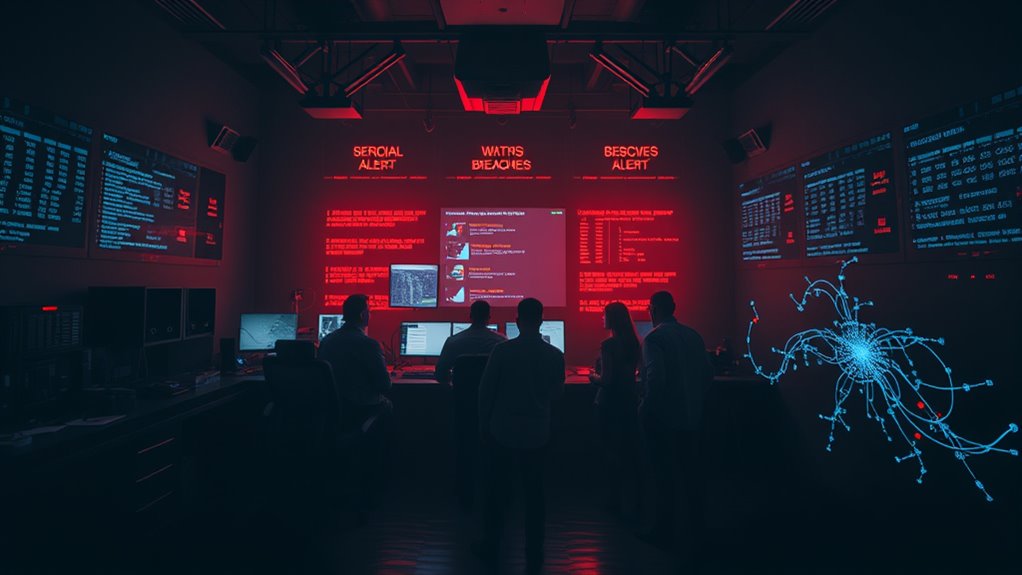Cyber espionage is at an all-time high, and it's affecting you and organizations everywhere. Attacks have surged dramatically, particularly against critical sectors, with tactics like sophisticated malware and spear phishing on the rise. Adversaries are more aggressive, taking advantage of vulnerabilities to steal sensitive data. The financial and reputational damage from these breaches can be severe. Understanding the threat landscape is essential for protection. Stay informed to safeguard yourself and your organization against these ongoing attacks.
Key Takeaways
- Cyber espionage threats have surged, with attacks linked to adversaries increasing by 150% and critical industries facing a 300% rise in targeted threats.
- Advanced persistent threats (APTs), malware, and spear phishing are common tactics used by attackers to extract sensitive information.
- Countries like China and Iran are exploiting vulnerabilities using sophisticated methods, including AI-powered deception for increased effectiveness.
- Organizations must implement strong password policies, multi-factor authentication, and regular software updates to mitigate potential cyber threats.
- The consequences of cyber espionage include substantial financial losses, reputational damage, and operational disruptions, necessitating proactive defensive measures.

As the digital landscape evolves, cyber espionage has become a pressing threat that targets sensitive information across various sectors. You may not realize it, but you're likely within reach of sophisticated attacks designed to gather intelligence through cyber spying. This threat isn't confined to large corporations or government bodies; it extends to businesses of all sizes and critical industries, making vigilance essential.
Motivations behind cyber espionage often stem from geopolitical advantages, economic espionage, and competitive intelligence gathering. In a world where data is currency, hackers are increasingly aggressive, deploying advanced persistent threats (APTs), malware, and social engineering tactics to infiltrate your systems.
Motivations for cyber espionage include geopolitical advantages and economic gain, driving hackers to deploy advanced tactics against your systems.
Malware, like Trojans and ransomware, can wreak havoc, while spear phishing techniques specifically target you or your colleagues, tricking them into revealing confidential information.
With the rise of AI-powered deception, cyber espionage has become even more sophisticated. Attackers exploit gaps across endpoints, cloud, and identity systems, making it increasingly difficult for you to spot and thwart these intrusions.
The surge in attacks from adversaries, particularly those linked to China, has skyrocketed by 150%, with critical industries witnessing a staggering 300% increase in targeted threats. This means your organization could be next on the list. Moreover, this increase is accompanied by a rise in aggressive tactics employed in espionage operations.
The global cyber espionage landscape is evolving, with countries like Iran also employing AI to conduct vulnerability research and exploitation. As attackers continually adapt their methods, it's crucial for you to stay informed about emerging threats.
International cooperation is vital to combat this global menace, but the onus often falls on individual organizations to bolster their defenses.
You might wonder how to protect your sensitive data. Strong password policies, regular software updates, and security awareness training can go a long way. Incorporating multi-factor authentication adds another layer of security, making it harder for cybercriminals to gain access.
Having an incident response plan is also essential, enabling quick recovery should an attack occur.
Ultimately, the impact of cyber espionage is profound, leading to financial losses, reputational damage, and operational disruptions. By understanding these tactics and taking proactive measures, you can help mitigate the risks associated with cyber espionage.
Frequently Asked Questions
How Can Individuals Protect Themselves From Cyber Espionage Attacks?
To protect yourself from cyber espionage attacks, start by using strong, unique passwords for all your accounts and enable multi-factor authentication whenever possible.
Keep your software and anti-virus programs updated to patch vulnerabilities. Be cautious with emails from unknown sources to avoid phishing scams.
Additionally, consider encrypting sensitive data and regularly back up important information. Staying informed about emerging threats will help you recognize and respond to potential risks effectively.
What Are Common Signs of a Cyber Espionage Breach?
You should watch for several signs of a cyber espionage breach.
Unusual outbound traffic and spikes in data traffic can indicate data exfiltration.
Look out for unauthorized access attempts and unexplained configuration changes.
Pay attention to suspicious emails, especially those with urgent content or unknown sender addresses.
Additionally, monitor for multiple failed login attempts and unusual user behavior, as these can signal compromised accounts or unauthorized access to sensitive information.
Which Industries Are Most Targeted by Cyber Espionage?
Cyber espionage mainly targets industries like manufacturing, financial services, healthcare, and energy.
You'll notice that manufacturing faces over 25% of all cyberattacks. Financial institutions are prime targets due to their sensitive data, while healthcare is increasingly vulnerable because of valuable medical records.
Energy and utilities are also at risk, as attacks can disrupt critical infrastructure.
Staying informed about these threats can help you protect your organization from potential breaches.
How Do Governments Respond to Cyber Espionage Threats?
Governments grapple with growing cyber threats through a mix of measures.
They're implementing laws to regulate cybersecurity, forming partnerships for international cooperation, and establishing cybersecurity agencies to monitor risks.
You'll notice them promoting public awareness campaigns and developing regulatory frameworks to ensure compliance.
On the defensive front, they're enhancing network security, utilizing encryption, and crafting incident response plans, all while training employees to tackle potential threats effectively.
What Technologies Are Used in Cyber Espionage Activities?
In cyber espionage, various technologies are used to infiltrate systems and gather sensitive information.
You might encounter malware injections that install harmful software, phishing attacks that trick you into revealing personal data, and zero-day exploits that take advantage of unpatched vulnerabilities.
Social engineering tactics manipulate your behavior, while advanced persistent threats maintain long-term access for sustained data extraction.
Tools like screen grabbers and key loggers also capture vital information discreetly.
Conclusion
In times like these, it's clear that "forewarned is forearmed." As cyber espionage threats grow, staying vigilant and informed is crucial. Don't let complacency set in—protect your data and your digital life. Remember, the best defense is a good offense. By taking proactive steps today, you can shield yourself from potential attacks tomorrow. So, gear up, stay alert, and don't underestimate the power of cyber threats. Your security depends on it.









